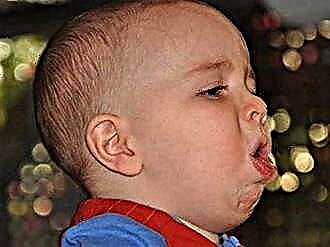A cough in a child can be caused not only by an infection in the throat, but also by snot accumulated there. They run down the back of the larynx, and the baby begins to choke and cough. If you do not take action in time and do not get rid of this problem, bronchitis and even bronchial asthma can develop. And the constantly present mucus in the nasopharynx is a real breeding ground for infection, which can cause sinusitis or otitis media.
Causes of mucus accumulation
 Before you begin to treat the thick snot flowing down the nasopharynx, you need to find out as accurately as possible what caused their appearance. If we break down all the possible causes into groups, then they can be: allergic, non-infectious and infectious. But we will not make a detailed classification, but only list those for which thick snot appears in a child as often as possible:
Before you begin to treat the thick snot flowing down the nasopharynx, you need to find out as accurately as possible what caused their appearance. If we break down all the possible causes into groups, then they can be: allergic, non-infectious and infectious. But we will not make a detailed classification, but only list those for which thick snot appears in a child as often as possible:
- Dry and / or too warm air in the room where the child is for a long time. It leads to overdrying of the mucous membranes. They begin to secrete more secretion, but a thicker consistency to stay hydrated.
- The constant presence of the allergen. It can be anything: house dust, animal hair, tobacco smoke soaked in furniture, pollen, etc. If the allergic reaction is mild, it may hardly show up externally. The child will not have a severe cough, skin rash, or other obvious signs. But the mucous membranes of the nasopharynx will be constantly irritated, more snot and mucus will be released. This can also include irritating external factors - smoke, too strong odors, etc.
- Foreign small object caught in the nose or nasopharynx (as an option - grains, grains of sand, lumps of dust, hairs). It can practically not obstruct breathing, but it still constantly irritates the mucous membrane, causing a return abundant mucus secretion.
 Anatomical features of the structure or trauma to the nose, due to which the nasal septum is curved, difficulty breathing and normal mucus production. Snot, not having a free outlet to the outside, accumulates, thickens and then flows down the throat.
Anatomical features of the structure or trauma to the nose, due to which the nasal septum is curved, difficulty breathing and normal mucus production. Snot, not having a free outlet to the outside, accumulates, thickens and then flows down the throat.- Infectious causes. When pathogens enter the nose, mucus is produced as a defense reaction. And if at first it is liquid, then as the disease develops, it thickens. With severe swelling or congestion, mucus also flows into the nasopharynx. In this case, treatment should be started immediately.
In a baby, there is another additional reason associated with physiological characteristics. A lot of saliva and mucus is secreted during active teething. Throughout this period, you must carefully monitor so that the child's head is not thrown back, especially during sleep. No treatment will help in this case, you just need to wait this time out.
Home treatment
If thick snot has recently appeared in a child and does not have a pronounced green, yellow or orange color, indicating a large number of pathogenic microorganisms, then you can try to cure them with home methods. Proven folk remedies are absolutely safe, and at the initial stage of even a viral disease are sometimes no less effective than pharmaceutical preparations.
 Treatment should be started with a thorough rinsing of the nose. This can be done with a solution of sea salt (1 tsp per glass of water), chamomile decoction, furacilin. Before rinsing, you should try to remove snot from the nose by blowing it out or pulling it out with an aspirator.
Treatment should be started with a thorough rinsing of the nose. This can be done with a solution of sea salt (1 tsp per glass of water), chamomile decoction, furacilin. Before rinsing, you should try to remove snot from the nose by blowing it out or pulling it out with an aspirator.
Older children can draw in water on their own by closing one nostril. For babies, you can fill it with a syringe without a needle or a soft little syringe. In this case, the head should be tilted down, and the pressure of the water is not too great so that the snot does not fall into the ears.
After rinsing, the spout must be dripped. As drops, you can use:
- Oil solution of essential oils: eucalyptus, calendula, mint, fir, pine, sage. In a teaspoon of sea buckthorn, olive or ordinary sunflower oil, add 2-3 drops of essential oil and mix well. Enough 2-3 drops of the mixture in each nostril. This solution has excellent emollient, moisturizing, anti-inflammatory and even antibacterial properties.
- Aloe or Kalanchoe juice with honey. Not only quickly relieves inflammation on the back of the throat, but also promotes the healing of wounds and microcracks, if such are present on irritated mucous membranes. It is able to relieve a sore throat and even treat the early stage of bronchitis. Kalanchoe juice perfectly relieves nasal congestion, as it causes a reflex sneezing. It must be prepared immediately before use in order to preserve all the useful properties. Mix freshly squeezed juice with honey in equal amounts and drip 3-5 drops.
 Infusions of medicinal herbs: chamomile, calendula, sage, lavender, mint, St. John's wort (not for babies!). The infusion should be concentrated. To prepare it, take a tablespoon of dry crushed selected plant, pour it in a thermos with a glass of boiling water and leave for at least 2-3 hours (preferably overnight). Strain the tincture and instill 3-5 drops up to 5 times a day. To enhance the effect, you can add honey.
Infusions of medicinal herbs: chamomile, calendula, sage, lavender, mint, St. John's wort (not for babies!). The infusion should be concentrated. To prepare it, take a tablespoon of dry crushed selected plant, pour it in a thermos with a glass of boiling water and leave for at least 2-3 hours (preferably overnight). Strain the tincture and instill 3-5 drops up to 5 times a day. To enhance the effect, you can add honey.
Home inhalations with decoctions of the above herbs or steam from potatoes give a good effect. If there is no inhaler, then you can sit the child over a bowl of broth, cover his head with a towel (not completely, leave air access!) And let him breathe for 5-10 minutes.
Drug therapy
If home methods do not help, and snot continues to accumulate on the back of the throat, then two options are possible: they have a non-infectious cause and an urgent need to look for it, or the disease develops and you will have to use antibiotic nasal drops. The doctor should prescribe such treatment, taking into account the age and general physical condition of the child.
Many mothers try to treat snot on the back of the nasopharynx with vasoconstrictor drugs. In most cases, they are ineffective, and sometimes even exacerbate the problem, as they greatly dry out the mucous membranes.
In addition, they have a number of contraindications. Therefore, we strongly recommend that you consult with your doctor before using them.
An excellent medicine is the natural pharmaceutical preparation "Pinosol". It is based on vegetable and essential oils, which perfectly help to remove inflammation of the nose and throat, and have quite strong antibacterial properties. The medicine envelops the mucous membranes of the nose and lingers on the back wall of the nasopharynx, creating a protective film.

 Anatomical features of the structure or trauma to the nose, due to which the nasal septum is curved, difficulty breathing and normal mucus production. Snot, not having a free outlet to the outside, accumulates, thickens and then flows down the throat.
Anatomical features of the structure or trauma to the nose, due to which the nasal septum is curved, difficulty breathing and normal mucus production. Snot, not having a free outlet to the outside, accumulates, thickens and then flows down the throat. Infusions of medicinal herbs: chamomile, calendula, sage, lavender, mint, St. John's wort (not for babies!). The infusion should be concentrated. To prepare it, take a tablespoon of dry crushed selected plant, pour it in a thermos with a glass of boiling water and leave for at least 2-3 hours (preferably overnight). Strain the tincture and instill 3-5 drops up to 5 times a day. To enhance the effect, you can add honey.
Infusions of medicinal herbs: chamomile, calendula, sage, lavender, mint, St. John's wort (not for babies!). The infusion should be concentrated. To prepare it, take a tablespoon of dry crushed selected plant, pour it in a thermos with a glass of boiling water and leave for at least 2-3 hours (preferably overnight). Strain the tincture and instill 3-5 drops up to 5 times a day. To enhance the effect, you can add honey.

